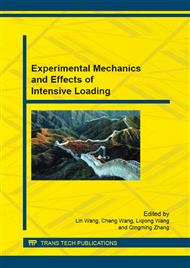[1]
Kent D, wang G, Yu Z, Dargusch MS. Pseudoelastic behavior of a beta Ti-2. 5Nb-3Zr-3Mo-2Sn alloy [J]. Mater Sci Eng. A 2010;527: 2246-52.
DOI: 10.1016/j.msea.2010.03.060
Google Scholar
[2]
Kim JH, Semiatin SL, Lee CS. Constitutive analysis of the high-temperature deformation mechanisms of Ti-6. 85Al-1. 6V alloys [J]. Mater Sci Eng A 2005, 394: 366-75.
Google Scholar
[3]
Xu W, Kim KB, Das J, et al. Phase stability and its effect on the deformation behavior of Ti-Nb-Ta-In/Cr beta alloys [J]. SCr mater 2006, 54: 1943-8.
DOI: 10.1016/j.scriptamat.2006.02.002
Google Scholar
[4]
Qian Song Wei, Shoujin Sun, Suming Zhu et al. Compressive deformation behavior of α near-beta titanium alloy [J]. Material and Design, 2012, 34: 739-735.
DOI: 10.1016/j.matdes.2011.06.049
Google Scholar
[5]
Jones NG, Dashwood RJ, Jackson M, et al. β phase decomposition in Ti-5Al-5Mo-5V-3Cr [J]. Acta Material, 2009, 57: 3830-3839.
DOI: 10.1016/j.actamat.2009.04.031
Google Scholar
[6]
Zhou Wei, GE Peng. Hot deformation behavior of Ti-5553 alloy, The Chinese Journal of Nonferrous Metals, 2010, 20 (1): 852-856.
Google Scholar
[7]
Xu Feng, Ji Bo. Effect of process routes on mechanical properties and microstructure of Ti5553 isothermal forgings [J]. The Chinese Journal of Nonferrous Metals, 2010, 20 (1): 100-103.
Google Scholar
[8]
Jun Huang. Cyclic deformation response and fatigue behavior of metastable-βTi5553 alloy [D]. Hefei: Hefei university of technology, (2011).
Google Scholar
[9]
Zhao Denghui, WANG Lin. Microstructures and mechanical properties of near-betaTi-5553 alloy under high strain rate loading [C]. Chinese journal of stereology and image analysis, Taiyuan, 2013: 18 (4).
Google Scholar
[10]
M.K. Koul, J.F. Breedis, in: R.I. Jaffee, N.E. Promisel (Eds. ), The Science, Technology and Application of Titanium, Pergamon Press, Oxford, 1970, p.817–828.
DOI: 10.1016/b978-0-08-006564-9.50089-0
Google Scholar
[11]
T.W. Duerig, J. Albrecht, D. Richter, et al. Formation and reversion of stress induced martensite in Ti-10V-2Fe-3Al [J]. Acta Metall. 30 (1982) 2161–2172.
DOI: 10.1016/0001-6160(82)90137-7
Google Scholar
[12]
T. Grosdidier, M.J. Philippe. Deformation induced martensite and superelasticity in a β-metastable titanium alloy [J]. Mater. Sci. Eng. A 291 (2000) 218–223.
DOI: 10.1016/s0921-5093(00)00921-7
Google Scholar
[13]
T. Zhou, M. Aindow, S.P. Alpay. at el. Pseudo-elastic deformation behavior in a Ti/Mo-based alloy Scr [J]. Mater. 50 (2004) 343–348.
DOI: 10.1016/j.scriptamat.2003.10.012
Google Scholar
[14]
Q.Y. Sun, S.J. Song, R.H. Zhu, et al. Toughening of titanium alloys by twinning and martensite transformation [J]. Mater. Sci. 37 (2002) 2543–2547.
Google Scholar
[15]
M.A. Meyers, Dynamic Behavior of Materials, John Wiley & Sons, Inc., New York, (1994).
Google Scholar
[16]
N.K. Bourne, J.C.F. Millett, G.T. Gray III, J. Mater. Sci. 44 (2009) 3319–3343.
Google Scholar
[17]
Yu Ren, Fuchi Wang, Chengwen Tan. Effect of shock-induced martensite transformation on the postshock mechanical response of metastable β titanium alloys [J]. Journal of Alloys and Compounds. 2013: 547-553.
DOI: 10.1016/j.jallcom.2013.07.028
Google Scholar
[18]
Zhang Chunyan, ZhaoYongqing. Titanium and applications [M]. Chemical Industry Press, (2004).
Google Scholar
[19]
Liu Hong-Tao, Sun Guang-Ai Shock-induced transformation behavior in NiTi shapememory alloys [J]. Acta Physica Sinica. 2013: (62), 1.
Google Scholar
[20]
H.J. Rack. Residual strength of shock loaded RMI36844 [J]. Metallurgical Transactions (1571), (1976).
Google Scholar
[21]
A. Bhattacharjee, V.K. Varma, S.V. Kamat, A.K. GoGia, S. Bhargava, Metall. Mater. Trans. 37A (2006) 1423–1433.
Google Scholar
[22]
Zhang fan, Hao Min, Tan Chengwen et al. Shock –loading Response of Mg-Gd and AZ31 wrought Magnesium alloys[J]. Chinese journal of rare mentals, 2012: 201-208.
Google Scholar
[23]
B H Scencer, Maloy S Ai, Gray Ⅲ G T. The influence of shock-pulse shape on the structure/property behavior of copper and 316 L austenitic stainless steel [J]. Acta Materialia, 2005, V53 (11) : 3293-3303.
DOI: 10.1016/j.actamat.2005.03.037
Google Scholar
[24]
Cerreta E, Gray III G T, Lawson A C, et al. The influence of oxygen content on the α to ω phase transformation and shock hardening of titanium [J]. Journal of Applied Phisics, 2006, V100: 013530.
DOI: 10.1063/1.2209540
Google Scholar


